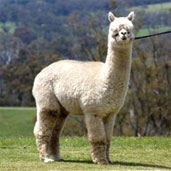About Alpacas

Alpaca breeders around the world have found farming Alpacas not only one of the most profitable farming alternatives, but that Alpacas are people friendly, earth-kind, gentle, inquisitive creatures that grow superb and rare fleece - one of the most valuable known to man.
The lifestyle they offer is both enjoyable and rewarding. To this end the Coolawarra Alpaca Stud offers its clients a total management service - a complete breeding programme, experienced veterinary service, agistment services and a full reporting service
Alpacas are members of the camelid family and until the 1980s were only bred in their native South America. They have been domesticated for fine cloth production for thousands of years, the Merino equivalent, of the South American civilisation.
- Alpacas are gentle and curious by nature, easily handled and halter-trained to lead.
- They have a gracefully vague resemblance to the fabled 'push-me-pull-you' child's toy. They weigh around 70kgs and their gait is more akin to that of a camel.
- Alpaca fibre is silky soft, lightweight, yet durable - rare qualities that meet the demands of the modern consumer at-home in haute couture throughout Italy, Korea and Japan.
- Alpacas are economical eaters but, unlike other domestic livestock, they have soft fibro elastic pads more akin to our native kangaroo, minimising the environmental impact on our delicate Australian terrain.
- Whilst Alpacas eat pasture close to the ground, they do not tear the plant. When the Incas first saw sheep they named them 'fire mouth' as sheep loosen and can tear the vegetation out of the ground.
- Breeding one cria (offspring) per year, they rarely twin. Today's artificial reproduction methods have not been successfully applied to Alpacas and are far from commercial consideration at this point.
- Lifespan is approximately 20 years and the maiden female is first mated at one year. With gestation being 11 1/2 months, the adult female has her first cria at about 2 years, then breeds one cria per year.
- Alpacas birth only in daylight and delivery is relatively trouble free. The cria are often standing and drinking within an hour of arrival.
- Alpacas spit to ward-off intruders or the attention of an amorous male. This harmless behaviour is their main source of defence. They rarely spit at people.
The alpaca is an outstanding example of domesticated selected breeding. It is a people friendly, earth-friendly, easily-managed farm animal that up to the 15th Century produced a fleece that assisted the building of one of the greatest Empires known to man, that of the ancient Incas.
Unfortunately, 500 years ago the conquerors, failing to see the potential of the alpaca, preferred the merino sheep of their native Spain. Sadly, the industry fell into disarray over the following centuries due to annihilation by, the introduction of European stock diseases, mismanagement and turbulent politics.
Then in the early 19th Century, with very limited quantities available for textile manufacturing, Europe began craving for alpaca having discovered its unique properties more by mistake than vision. From this evolved a textile industry in Peru with exports of fleece, especially to Japan, Korea and Europe, maintaining a thriving industry. The animal however, remained locked in its South American homelands due to lack of disease control. In fact it was not until the 1980s the export of camelid was initiated, first to the United States and then to Australia, via New Zealand.
The Challenge
For Australian Alpaca breeders the challenge is to build an industry
with an animal previously unexposed to modern Australia breeding techniques.
Even with the fleece in its relatively untouched state it rubs shoulders
with the rarest and most beautiful natural fibres in the world, therefore
potential for improvement is vast.
